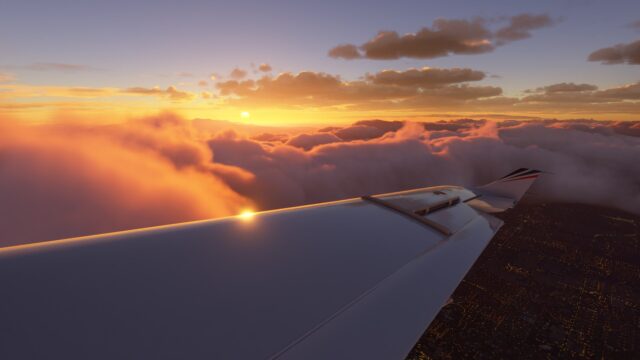
Its official name is Microsoft Flight Simulator (their official Facebook is here), and a few people, youtubers, content creators, journalists went to Seattle and met with a part of the developers to get many details. They have been also able to fly a pre-Alpha version.
Information have spread everywhere, and it’s good to take a pause, sum up the confirmed facts and features.. This may avoid you to read dozens of webpages, watch dozens of videos, and read dozens of pages in a forum with mixed information.
FSElite and Frooglesim have been our main sources for this quick summary. Visit their website and YouTube account for in depth details.
Scenery technology
It’s the key where Flight Simulator will hit other competitors. It will set the new standard of the next generation in PC flight simulation.
- 2 PetaBytes (= 2,000 TeraBytes of world scenery)
- No local storage on your hard disk, but scenery data streaming via Internet then local rendering on your PC. 3 modes available for the streaming :
- Adaptive Streaming : maximum scenery data details upon your Internet connection speed and reliability
- Fully Offline Mode : no Internet required, you fly the default scenery provided out of the box, still good enough for VFR but with much less storage required than 2 PB!
- Pre-Cache Mode : same scenery data than with the Adaptative Streaming mode, with all details, but you download a selected area before your flight performed without any Internet connection.
- Combination of Microsoft Bing maps for the terrain textures and elevation data (LOD 19) with procedural 3D generation of buildings (of all sorts : houses, industrial, plants, sheds, piers..), trees, water, dirt, grass, roads, lights upon the terrain analysis
- Streaming strength and world generation made possible with new technology named Azure and an advanced Artificial Intelligency for the terrain analysis.
- 40,000 airports and 400 HD cities included
- Smooth and natural transition day / night without textures loading effects
Aircraft and Cockpit
- New instruments data : new analog gauges and glass cockpit
- New GPS and FMS
- Touch screens simulation
- Interactive and automatic check-lists (optional) with camera zoom-in to the panel that needs a check or control, popup tips will help beginners
- New cockpit lights
- Support of flight sticks, yokes, pedals and other devices
- Multi-display support
- Shared cockpit is only an idea they are thinking about
- General aviation and jets included
- Helicopters : none at the moment, maybe later
Environment and Simulator Engine
- Based on the FSX core with many and vastly revamped systems
- New sky simulation engine
- Particle effects : rain droplets, run on your windshield according to speed and wind conditions
- Precise localization : see rain forming, clouds shaping, and fly through it
- New air mass simulation :
- many different layers in atmosphere,
- wind movements based on the landscape shapes and elevation
- updrafts/downdrafts simulation,
- windshear, blow, wingtip vortices, wake turbulence behind other aircraft simulated and affecting precise parts of your body
- New flight dynamics : 1000 surfaces analyzed on your aircraft model, friction / braking / skidding advanced settings.
- New collision model
- 600 km drawing distance ( about 323 nm, 372 miles )
- Physically Based Rendering (PBR) materials : advanced visuals of shiny surfaces, lights behaviour changes upon surface material, shape and the weather/lights conditions
- All environmental elements can be lit or reflected in the water, the clouds, shaded
- Dynamic shadows and reflections
- 4K display
- Dynamic camera included
- No Raytracing technology support ( of the latest graphics cards )
- DirectX 11 library
- Improved audio system
- No VR support at launch, maybe later
General
- The development of the new Microsoft Flight Simulator (2020) started 5 years ago in secret.
- The game studios is Asobo, a French company already author of The Crew 2, Zoo Tycoon.. as big as 100 team members, all currently working on the simulator.
- Microsoft still communicates a lot on his commitment to the flight sim community, including third party developers
- A legacy mode will be included to ease the use of older add-ons (that were SDK compliant we guess, forget about advanced airliners with custom coded systems)
- Microsoft Flight Simulator is clearly oriented to the hardcore simmers on PC. The Xbox version is an adaptation. Rookies will be guided to get their wings.
- No release date, no PC hardware requirements, no pricing information for now.


“No local storage on your hard disk”
Dat kan volgens mij wel, via cache. Uiteraard niet volledig, maar een deel.
Even over diskruimte (en kort door de bocht): 2000TB / 6 ~ 300TB a 400TB per continent.
Of course,you have to read that we don’t have to manage 2 PB permanently for the Global Scenery on the local disk. The aircraft models, the Sim itself, will need local storage. This is not a streaming display computed in the cloud.
“forget about advanced airliners with custom coded systems” Is this part of your guess or was it stated at the conference?
All that is between parenthesis is my guess.
Very good summary Sebastien, saves me from a lot of repetitive reading. I think P3D and ORBX are going to be the biggest losers. I’m holding off on any purchases for those two products until I see what FS2020 is all about. Developers still publishing for FSX have my support, but hopefully the hyped prices for P3D scenery will now be curtailed.